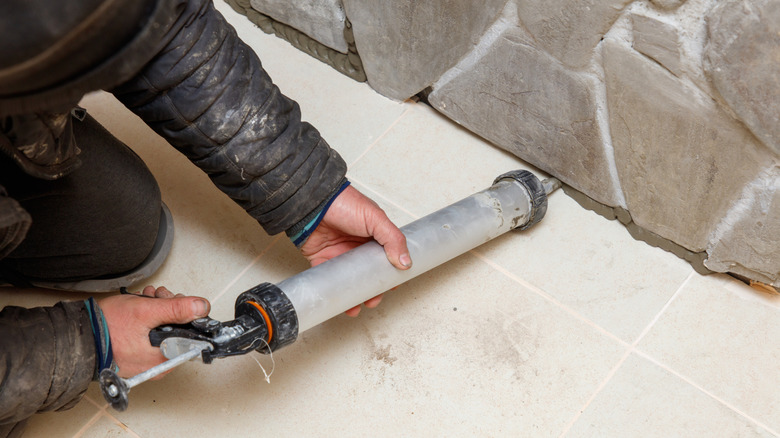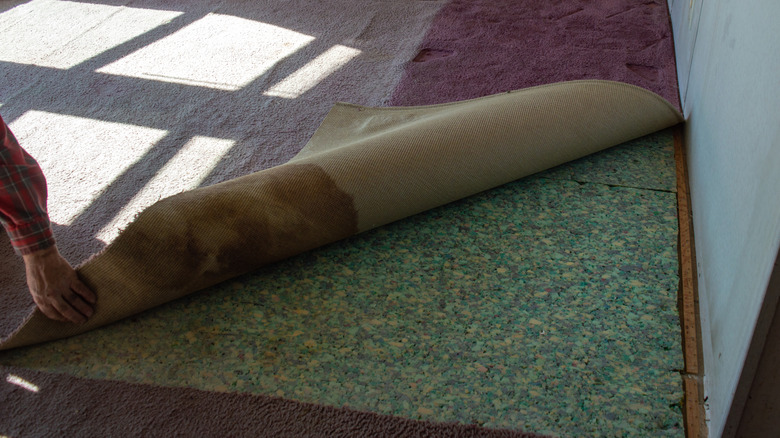The Affordable Home Repair Essential That Can Fix Loose Carpet (It's So Renter-Friendly)
Caulking finds its origins in seafaring vessels, wherein evidence exists of moss being used to fill the seams in maritime cargo ships for centuries. However, it has also become an essential part of homebuilding, whether you're using caulk to create waterproof seals between your bathroom tiles and appliances or you're filling gaps around the doors and windows to prevent heat loss. Caulk is a great jack-of-all-trades solution for anything from bolstering your insulation to keeping small pests out of your home, but it can also have unexpected uses, such as helping you fix loose carpet by re-sealing the outer edges without breaking the bank (or your lease).
Having loose carpet is more than just an aesthetic problem; carpet can easily become bunched up when it isn't properly sealed to the floor, and its fuzzy, sometimes patterned exterior can obscure that obstruction in visual noise. That means you're likely to trip over that carpet when you least expect it, or otherwise slip up when the unset floor suddenly moves beneath you. The Occupational Safety and Health Administration reports hundreds of deaths and innumerable more injuries every year from workplace slips, trips, and falls, and at home, you're probably less equipped to deal with that kind of hazard injury. Depending on the type of damage, it can also be expensive to have repairs made on your worn-down carpet. With caulk guns coming as cheap as $10 at retailers like Home Depot, there's little reason not to try DIYing your own solution to this loose carpet problem.
Using caulk to seal loose carpeting is a quick, safe solution you can do yourself
Installing carpet is typically an involved process that's best left to an expert, at risk of doing some permanent damage to your home's foundation. Tack strips, staples, glue, and other adhesives are all often used in varying combinations to hold carpet in place. Then, whether you're using a wet or dry adhesive, the carpet needs to be directly glued at a uniform rate across the entire length of the floor, which can later cause serious damage during removal if improperly set. Using caulk as a less permanent adhesive solution is thus a better way to approach the fix if you're renting your home or otherwise think you won't be able to get a repair team in for some time.
The process of using caulk to fix loose carpet should be similar to the last stages of easily installing carpet at home, skipping over some of the more tedious steps involved in rolling out, measuring, and cutting carpet to fit your living space. Once you've found the loose corner (or corners), you'll have to press it as flat as you can to prevent the carpet from bunching up again — any heavy object, from pieces of furniture to full storage boxes, should help you keep it down. From there you can lift the edges to run a line of caulk along the floor, about half an inch from the wall, and then tamp it down with heavy objects for at least a day to let the sealant set. It's best to leave a little extra loose space right at the edge of the wall in case you or an expert ultimately needs to peel up the carpet using a scraping chisel to perform a more permanent fix.
Be wary of problems that might arise when caulking your loose carpet
Using caulk to fix your loose carpet is a quick and cheap solution that anyone can try, but as expected, this also means it has a lot of room for error that you need to be aware of. For one thing, if you haven't fully flattened out the carpet, it could begin to buckle again and tear away the sealant. However, professional installers will also take time before affixing the carpet to inspect and clean the floor underneath for imperfections that might show through, so if you aren't thorough about removing dust and hair, it may lead to poor sealing.
Cleaning the floorspace underneath your carpet can lead to further problems if you do so improperly. If you don't give the floor proper time to dry, for example, you risk trapping extra moisture beneath the carpet. Water damage on carpets is difficult to fix under normal circumstances, but trapping water between the carpet and floor provides ample opportunity for potentially unfinished wood to warp and rot, or for mold to start growing in that dark, enclosed space that's only loosely sealed down by caulking. There are ways to safely remove problematic mold from your carpet, but this becomes a much harder prospect if you can't get to the source without tearing up the carpet all over again. Ultimately, you should be thinking of caulk as a temporary solution to your loose carpet woes, as an expert hired by you or your landlord will be able to give your home a cleaner resolution.


